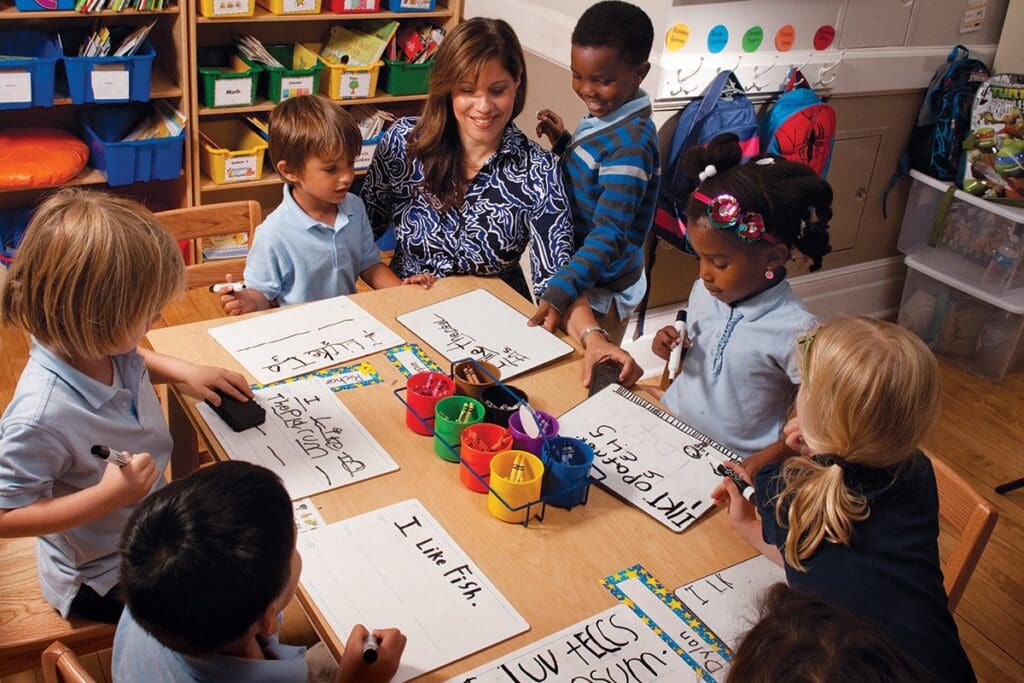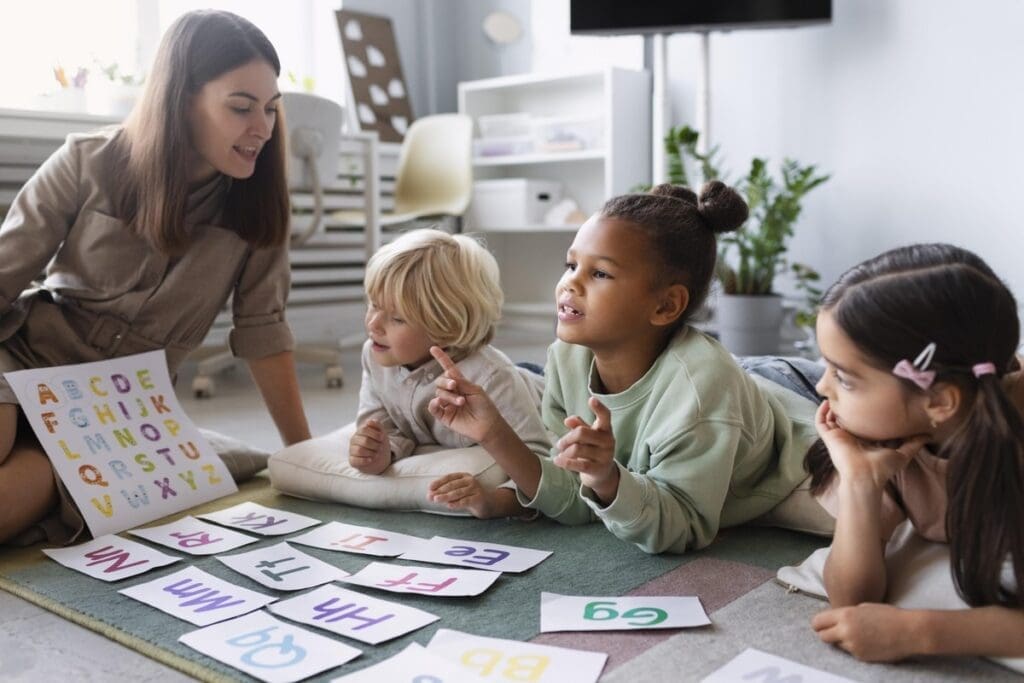Last Updated on November 24, 2025 by
A quality early childhood environment is key to a child’s growth and success later on. Studies show that the groundwork for a lifetime of success is set early in a child’s life.

Early learning essentials are key for helping children succeed in school and beyond. Recent studies found that kids in classrooms with qualified teachers do 20% better in language and math. The four main criteria for a quality early childhood environment are: teachers who are well-trained and supported, small class sizes, safe and welcoming spaces, and a full curriculum.
These factors are vital for giving kids a quality preschool education. They help prepare children for success in school and beyond.
Early childhood environments are key in shaping a child’s growth. They are vital for cognitive, social, and emotional development. Quality in these environments is essential, setting the stage for future success and lifelong learning.
Quality early childhood environments support children’s development. They significantly impact a child’s cognitive and social-emotional development. This prepares them for school and beyond.
Quality early childhood environments have a big impact on child development. They help with academic readiness, social skills, emotional intelligence, and physical health.
Children in high-quality early childhood programs do better academically and socially. They outperform peers in lower-quality settings.
Measuring early childhood environment quality is key to a child’s best start. The Early Childhood Environment Rating Scale (ECERS) is used for this. High-quality environments score above 6 out of 7, showing strong support for growth.
The ECERS looks at several aspects of early childhood settings, including:

By focusing on these areas, educators and policymakers can create supportive environments. These environments are essential for healthy development and future success.
Teachers are the heart of great early childhood education environments. They know a lot about how kids grow and learn. This knowledge helps them create fun and learning-friendly classroom environments.

Teachers need certain qualifications to work in early childhood education. Usually, they must have a bachelor’s degree in early childhood education or something similar. Some places might ask for extra certifications or licenses. These make sure teachers know how to teach and support kids’ growth.
Teachers need to keep learning to stay up-to-date. They can do this through workshops, conferences, and more education. These chances help teachers get better and keep improving early childhood education classrooms.
Teachers need support to do their best. Things like mentorship and regular feedback help a lot. When teachers feel supported, they’re more likely to stay. This keeps the classroom stable and helps kids learn better.
“Teachers are the key to creating a positive and productive learning environment. Supporting them is essential for the success of early childhood education.”
In short, good teachers are key for quality early childhood education. By focusing on their education, ongoing learning, and support, we can make sure kids get the best start in life.
Low child-to-teacher ratios are key in quality early childhood education. They allow teachers to give each child the attention they need. This way, educators can create a better learning environment.
The right child-to-teacher ratio changes with age. For example, infants (0-12 months) need a 1:3 ratio. Preschoolers (3-5 years) do best with a 1:7 or 1:10 ratio. Keeping these ratios is vital for learning in preschool settings.
Having the right number of teachers is good for behavior. With fewer kids, there are fewer behavioral problems. Studies show that programs with the right ratios have 15% fewer behavioral challenges.
Teachers can spend more time with each child. This helps them meet each child’s needs better. It makes for a more positive learning space.
“When teachers have fewer children to care for, they can provide more individualized attention, which leads to better behavioral outcomes.”
Low child-to-teacher ratios also mean more individualized learning opportunities. Teachers can plan lessons that fit each child’s needs and interests. This makes learning more fun and effective.
This approach helps children learn in their own way. It supports their unique needs and helps them grow.
Creating safe, stimulating, and inclusive spaces is key for young learners. A good environment keeps kids safe and helps them grow in many ways. It supports their thinking, social skills, and feelings.
Keeping children safe in early learning places is a top priority. Places must follow strict safety rules and meet certain standards. They need to have safe entry and exit points, soft floors, and gates to keep kids in.
It’s also important to check these places often and plan for emergencies. This helps find and fix any dangers.
Key safety measures include:
Designing spaces that spark curiosity and discovery is important. This means having different materials and activities for all kinds of learners. For example, art, science, and reading areas can help kids learn by doing.
Effective strategies for creating stimulating environments include:
Creating spaces that welcome all learners is vital. This means making places that are easy to get around and feel welcoming. It’s about making sure everyone can learn and feel included.
Principles of inclusive design include:
By focusing on safety, stimulation, and inclusivity, early childhood education settings can offer quality learning environments. These environments are essential for the growth and development of young children.
A good curriculum is key for kids’ learning in early childhood education. It should be fun, challenging, and meet the needs of all young learners.
Good early childhood curricula have a few important parts. They include clear learning objectives, developmentally-appropriate content, and flexible teaching strategies. These allow for teaching that fits different learning styles.
Studies show that deep engagement with learning helps kids grow skills like math or language. This makes curricula that focus on deep learning very important.
It’s vital to match the curriculum with developmental benchmarks. This means regular assessment and adaptation to meet children’s changing needs.
Family involvement is key to early childhood education success. Curricula that build strong partnerships between educators and families lead to better results.
By getting families involved, curricula help create a continuity of learning between home and school. This supports kids’ overall growth.
It’s key to follow the four criteria for a top-notch early childhood setting. This ensures quality preschool education. These criteria include having skilled teachers, small class sizes, safe and engaging spaces, and a full curriculum.
Settings that meet these standards create a caring environment that boosts learning. They use developmental checks and involve families. This leads to better school readiness and academic success later on.
By focusing on these important factors, educators and policymakers can make a difference. They can build environments that help young children grow in all areas. This prepares them for success in the future.
A successful early childhood education environment has a few key things. It needs teachers who are qualified and supported. It also needs a good ratio of children to teachers. The physical setting should be safe and engaging. And, the curriculum should be right for the child’s age and development.
Quality in early childhood settings is checked with tools like the Early Childhood Environment Rating Scale (ECERS). This tool looks at how teachers interact with children, the curriculum, and the physical space.
The child-to-teacher ratio changes with age. Younger kids need more teachers to get the attention they need.
Teachers are key in early childhood education. They give quality lessons, help with social and emotional growth, and make a positive learning space.
Families can help by going to parent-teacher meetings, helping out in class, and doing activities at home that match the curriculum.
Low child-to-teacher ratios mean more one-on-one time. This helps with behavior, learning, and leads to better school results.
Environments can be made inclusive by using materials for all, having adaptable tech, and making a welcoming space.
Intentional teaching is vital. It lets kids make choices, take risks, and solve problems. This builds their independence and self-learning skills.
Curricula can match developmental goals by using proven methods, checking on kids’ progress, and adjusting lessons for each child.
Subscribe to our e-newsletter to stay informed about the latest innovations in the world of health and exclusive offers!